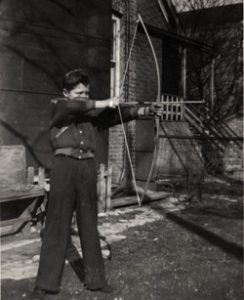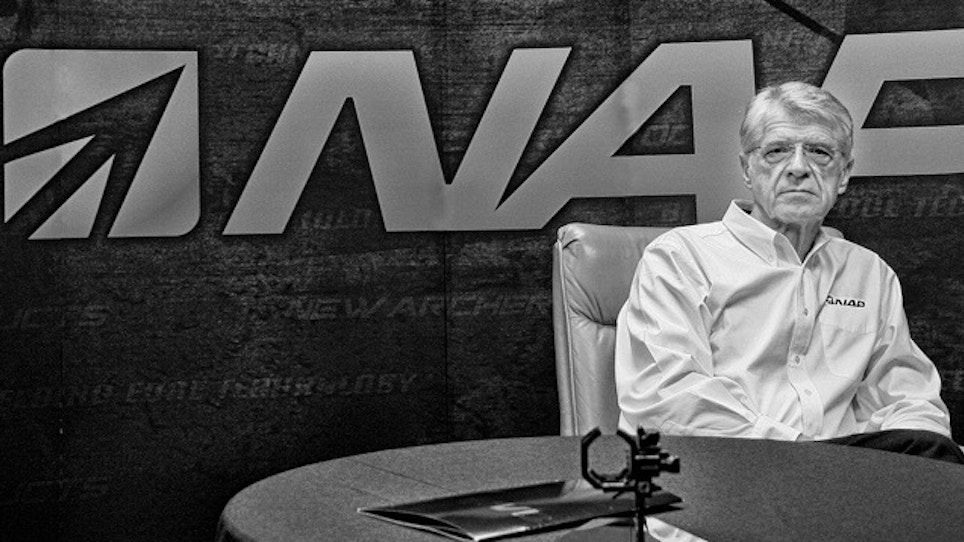It’s difficult for Gen-Xers and Millennials to fully grasp the significance of men like Andy Simo, who passed away May 18 at the too-young age of 79. Like Fred Bear, Ben Pearson, Doug Easton, Freddie Troncoso, Earl Hoyt, Holless Wilbur Allen, Tom Jennings, Jim Dougherty, and others who helped spawn the modern era of bowhunting, Andy was a visionary entrepreneur whose dedication to archery and bowhunting changed the game forever.
Andy combined his love for archery and a simple idea — the need for a better arrow rest — and developed the Flipper Rest in 1971. That product would become the basis for New Archery Products, a company that for decades gave us a ton of new gear, including such iconic products as the Thunderhead – still the most successful replaceable-blade broadhead of all time – the Spitfire mechanical broadhead, Quikfletch vane system, L.E.D. stabilizers and so many more.
Andy Simo’s story is anything but that of an overnight success, however. Born in 1938 in a two-room house in a small mountain village in what used to be known as Czechoslovakia, Hitler was only months away from invading nearby Poland, and World War II loomed on the horizon. “When I was four, I watched German tanks and troops march down the length of the valley and right through the village,” Andy once said. “Complicating everything was the fact that just before I was born, my father had immigrated to America. The plan was that my mother and I would follow shortly. But when Hitler's Panzer Divisions marched into Poland, everything changed. My mother tried to get us out of the country after I was only a few months old, but she was turned back several times.”
Andy’s father eventually settled near Chicago and began a small business. In early 1947, the war was finally over and he decided to go back into Czechoslovakia. He sold his business in America with the idea that he would return to the old country and his family, and open up his business there. Though the war had ended, when he arrived he discovered that the communists were taking over and that private businesses were being nationalized. So in October of 1948, he packed up the family and they all immigrated to America. Andy Simo was 10 years old and spoke no English.
As a young boy, Andy became enamored with model airplanes, which led to his receiving his aeronautical engineering degree at Purdue in the 1960's. “Those were heady times for anyone with an aeronautical engineering degree. Just a few years before the Russians had launched Sputnik, and America was running scared that it was behind in the space race,” Andy said. “The day I graduated I had job offers from a surprising number of firms. The offer I accepted was from Boeing in Renton, Washington, and here’s why. When I was growing up in Illinois, my father had a regular customer in his tavern named Butch McClorey. McClorey was a bowhunter, which was a pretty surprising thing for the time. He used to go up to Wisconsin bowhunting and every now and then he'd return with a deer, and I was so damned impressed with that. He would bring his bow into the tavern and let me look at it. I'd hold that bow, try to draw it, and just knew I had to have one. On my 18th birthday my father asked me what I wanted for a birthday present, and I told him I wanted a bow.” Andy shot that traditional bow all the way through college. Then, after graduation, when it came time to pick a company to work for, he chose Boeing because he thought Washington would be a great place to learn to bow hunt. “I may have been the only aeronautical engineer in history to select Boeing for that reason, he said.”
There Andy located a local archery shop -- Northwest Archery in Seattle, whose proprietor was none other than noted bowhunter Glen St. Charles, one of the original founders of the Pope and Young Club, and a good friend of Fred Bear’s. “I found myself in the midst of this seasoned group of bowhunters. We went elk and deer hunting and I learned how to make my own arrows. It was tremendous fun. That was in 1962, but after less than a year at the commercial aircraft plant in Renton, I was asked by the company to transfer to Huntsville, Alabama.”
Boeing had just landed a contract to work on the booster stage of the Saturn V moon rocket, and Andy soon found himself working as an engineering understudy for NASA. On his second day of work he was introduced to a pretty young secretary who, at the time, was working for one of the German rocket scientists that NASA employed. The young girl's name was Cherie. That was in May. That November, Cherie and Andy were married. His extra engagement present to her? He bought her a bow.
His Boeing career took him to New Orleans, then Marietta, Georgia, where he worked for Lockheed from 1965-71 – and where he also spent a lot of time at the Lockheed Archery Club. “Cherie and I shot almost every weekend,” Andy said. “We even rented a house that had a yard big enough so that we could shoot up to 60 yards. I also bowhunted every weekend during hunting season.”

Andy Simo has been shooting a bow, of one type or another, since he was a small boy in Czechoslovakia. He's shown shooting at age 11, shortly after he came to America. (Credit: New Archery Products)
By 1971, though, Lockheed was laying off huge numbers of engineers and Andy new his days were numbered. “Ever since college I'd thought about owning my own business,” he said. “While at Lockheed I'd gotten so immersed in archery that I began thinking seriously about starting a company to design, manufacture, and sell new archery products. It seemed that I was always tinkering with my archery equipment, and I had developed quite a few ideas on how to make things better. Given my engineering background, improved arrow rests seemed like the place to start.”
When the layoff finally came, Andy found himself at a turning point. “I could listen to my head and pursue yet another job in the aircraft industry. Or, I could listen to my heart and try to make a go of designing and manufacturing archery equipment. My heart, and archery, won out.”
In 1971 arrow rests were pretty simple affairs. Most bows came with carpet-type rests. After-market arrow rests consisted of a few stick-on rests of the bristle and feather type, along with a small handful of plastic and metal arrow rests. With most such rests, fletch clearance was a problem, arrow flight was effected and feathers wore out prematurely.
“I was obsessed with getting peak performance from my bows. I played with brace heights and modified limbs -- but I also worked continuously on better arrow rests,” Andy said. “I wanted a new rest that would be more forgiving, more precise. Gradually, I developed what would become my first new archery product -- the Flipper Rest. It was pretty advanced for the time. Originally the body was made out of stainless steel. Later it was injection molded out of nylon and reinforced internally with a brass bushing. The arrow sat on a Teflon-sleeved stainless steel arrow support arm. That arm folded out of the way at the slightest touch. Local archers loved them. I started making them in my basement, bending and soldering the arms myself. Each Flipper Rest sold for $3.50, making them one of the most expensive arrow rests on the market at the time. Then we put a small ad in a national archery magazine and more orders trickled in. Gradually demand grew. A few dealers even started ordering them in larger lots, and I hired a few high school kids to help me solder Flipper Rests in the evenings.”
The rest, as they say, is history. I first met Andy Simo in the early 1980’s, and got to know him better when I became the first editor of a national bowhunting magazine. In the 1990’s, when I was a freelance writer and an entrepreneur myself, I became a member of the New Archery Products pro staff. It was there I really got to know Andy Simo and his entire team, and was able to get my hands on several of his new designs to run them through torture testing in the field.
When I think of Andy now, the first word that pops into my head is “integrity.” A quiet guy until you got to know him, Andy always demanded quality in his products, and never in the “quick buck” mentality so often seen in business today. He believed in treating his employees fairly and well, and his customers even better. He never forgot where he came from, never forgot the sacrifices his parents made to help him have a better life, never forgot that the road to long-standing success is paved with hard work and honesty. In addition to his business, Andy also served on the Board of Directors for the Archery Manufacturers Organization (now ATA) from 1988 to 1994 and as Chairman of the Board from 1992 to 1994.
Andy Simo, you were the real deal. Your handshake was firm, and you always had a twinkle in your eye. You made a difference, and you will be missed.
Featured image: New Archery Products






